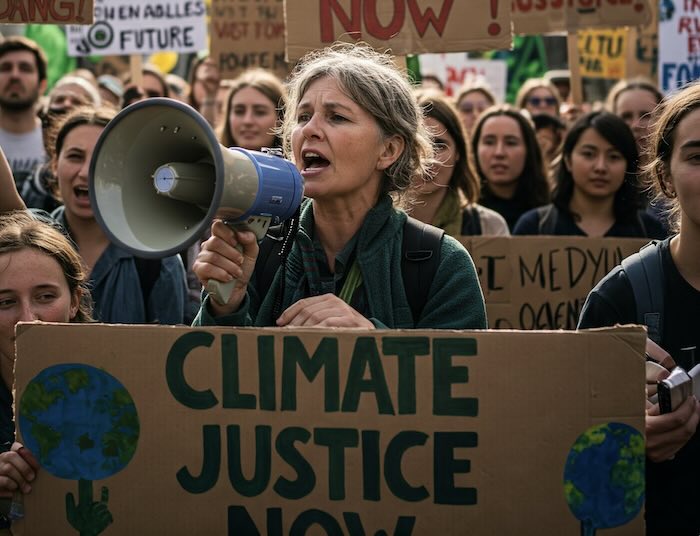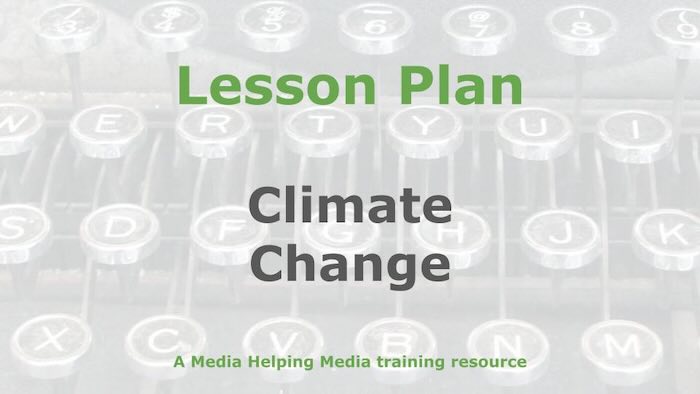
The following is a list of some of the common climate change terms used by scientists, environmental agencies, governments, activists, and journalists.
This short glossary has been compiled from various sources including the United Nations Development Programme (UNDP) ‘Climate dictionary‘. For a much longer list you might want to consider browsing the USA Environment Protection Agency’s (EPA) lengthy list.
We have edited the definitions in order to shorten them and, hopefully, make them easier to understand.
The glossary contains words and phrases that journalists will need to understand in order to cover climate change clearly and accurately. We have published it as a reference documents for any journalists reporting on environmental issues.
Adaptation: Adjusting to climate change impacts (e.g., building flood defences).
Afforestation vs. reforestation: Reforestation replants forests, afforestation creates new ones.
Anthropogenic: Caused by humans.
Blue economy: Sustainable use of ocean resources.
Carbon capture: The process of removing carbon dioxide from the atmosphere or emissions sources and storing it to prevent its release and mitigate global warming.
Carbon credits: Tradable certificates that represent the removal or reduction of one tonne of carbon dioxide or an equivalent greenhouse gas.
Carbon footprint: The amount of greenhouse gases released by an individual or organisation.
Carbon markets: Trading schemes for carbon credits.
Carbon neutrality: Signifies achieving a balance between emitting carbon dioxide and removing it from the atmosphere, so the net amount added is zero.
Carbon removal: The processes that extract carbon dioxide from the atmosphere and store it in long-term reservoirs, aiming to reduce the concentration of greenhouse gases.
Carbon sink: Natural reservoirs that absorb carbon dioxide (e.g., forests, oceans).
Climate action: Any measures taken to reduce greenhouse gas emissions and adapt to the impacts of climate change.
Climate change: The long-term shifts in temperatures and weather patterns, primarily caused by increased greenhouse gas emissions from human activities.
Climate crisis: The serious problems caused by climate change, including extreme weather, sea-level rise, and ecosystem damage.
Circular economy: Minimising waste and pollution.
Climate finance: Funding climate action.
Climate impacts: The observable consequences of altered climate patterns, such as increased frequency of extreme weather events, sea-level rise, and changes in ecosystems.
Climate justice: Fair distribution of responsibility and impacts related to climate change.
Climate overshoot: Temporarily exceeding climate targets.
Climate security: Managing climate-related risks to peace.
Climate mitigation: Actions taken to reduce greenhouse gas emissions and slow the rate of climate change.
Climate model: A computer simulation of the Earth’s climate system used to predict future climate change.
Decarbonisation: Reducing greenhouse gas emissions.
Deforestation: The clearing of forests for other land uses, such as agriculture or development.
Ecosystems: Complex communities of living organisms and their physical environments that are being disrupted and altered by rising temperatures, changing precipitation patterns, and other climate-related impacts.
Ecosystem damage: The negative alteration or destruction of the natural components and functions of an ecological system.
Ecological systems: Interconnected communities of living organisms and their physical environments, which are being disrupted by rising temperatures, altered precipitation patterns, and other climate-related changes.
Emission: The release of a substance, such as a gas or pollutant, into the environment.
Extreme weather: Weather events that are significantly different from typical weather patterns, often characterised by unusual severity or intensity.
Feedback loops: Changes that reinforce themselves, such as melting ice leading to more warming.
Fossil Fuels: Non-renewable energy sources such as coal, oil, and natural gas, formed from the remains of ancient plants and animals.
Gas emissions: The release of gases into the atmosphere, particularly those that contribute to the greenhouse effect and climate change.
Global warming vs. climate change: Global warming is the rise in Earth’s temperature; climate change includes broader changes such as extreme weather.
Green jobs: Jobs that support environmental protection.
Greenhouse effect: The process by which certain gases in the atmosphere trap heat from the sun, warming the planet.
Greenhouse gases: Gases such as carbon dioxide and methane trap heat, causing global warming.
Impacts: The effects of climate change, such as sea-level rise, extreme weather events, and changes in ecosystems.
Indigenous knowledge: Utilising traditional knowledge for climate solutions.
Loss and damage: Addressing unavoidable climate impacts.
Mitigation: Reducing greenhouse gas emissions (e.g., renewable energy).
Nature-based solutions: Using ecosystems to address climate change (e.g., reforestation).
Natural components: The Earth’s systems, such as oceans, forests, and ice caps, that are being altered by rising temperatures and changing weather patterns, impacting their ability to regulate the climate.
Natural reservoirs: Environments such as forests, oceans, and wetlands that store carbon, and their health is crucial for regulating the Earth’s climate.
Net zero: Balancing greenhouse gas emissions with removals.
Ocean resources: The ocean’s vital roles in absorbing carbon dioxide and heat, and the marine ecosystems that are impacted by rising temperatures and acidification.
Paris agreement: An international agreement on climate change adopted in 2015, aiming to limit global warming to well below 2 degrees Celsius above pre-industrial levels.
Precipitation patterns: The changes in the amount, timing, and distribution of rainfall and snowfall, which are being altered by rising global temperatures, leading to increased variability and more extreme events like floods and droughts.
RCP scenarios: A representative concentration pathway (RCP) is a possible future climate outcomes based on varying concentrations of greenhouse gases in the atmosphere.
Reforestation: The process of replanting trees in areas where forests have been cleared.
Regenerative agriculture: Farming that restores soil health.
Renewable energy: Energy from natural sources (e.g., solar, wind).
Resilience: Building the capacity to withstand climate impacts.
Rewilding: Restoring ecosystems.
Sea-level rise: The increase in the average global sea level due to the melting of glaciers and ice sheets, and the expansion of seawater as it warms.
Tipping points: Irreversible changes, such as melting ice sheets.
Vulnerability: The degree to which a system is susceptible to the adverse impacts of climate change.
Weather vs. climate: Weather is short-term, climate is long-term averages.
Weather events: More frequent and severe occurrences of phenomena such as heatwaves, droughts, floods, and storms.
Weather patterns: The long-term trends and variations in atmospheric conditions, which are being altered by rising global temperatures and increased greenhouse gas concentrations, leading to more frequent and intense extreme weather events.
This glossary is by no means exhaustive, but it provides a basic overview of some of the most common terms used in discussions of climate change. It’s important to note that the meanings of some of these terms can vary depending on the context.
Lesson plan for trainers
If you are a trainer of journalists we have a free lesson plan: Climate Change which you are welcome to download and adapt for your own purposes.









